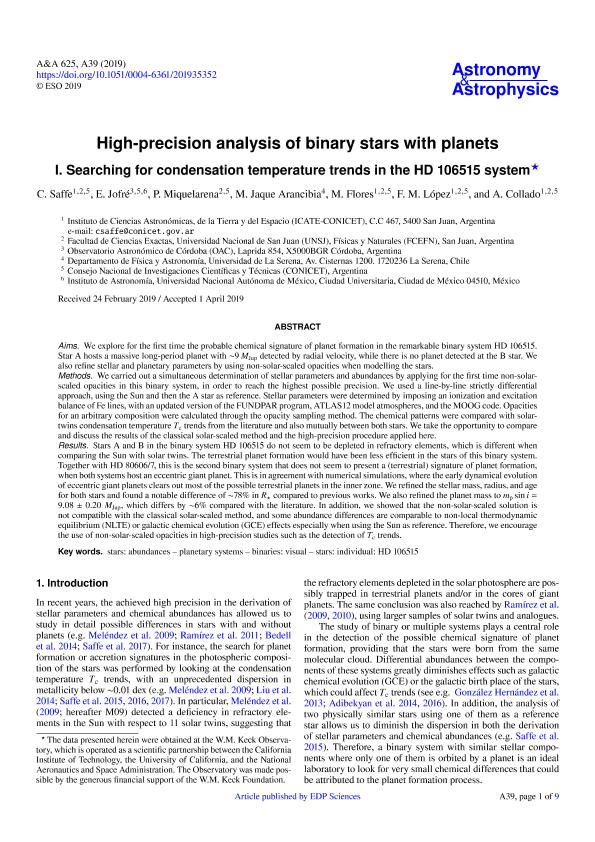Mostrar el registro sencillo del ítem
dc.contributor.author
Saffe, Carlos

dc.contributor.author
Jofre, Jorge Emiliano

dc.contributor.author
Miquelarena Hollger, Paula Andrea

dc.contributor.author
Jaque Arancibia, Marcelo Daniel

dc.contributor.author
Flores Trivigno, Matias Gaston

dc.contributor.author
López, Fernando Marcelo

dc.contributor.author
Collado, Ana Elisa

dc.date.available
2021-02-04T14:05:08Z
dc.date.issued
2019-04
dc.identifier.citation
Saffe, Carlos; Jofre, Jorge Emiliano; Miquelarena Hollger, Paula Andrea; Jaque Arancibia, Marcelo Daniel; Flores Trivigno, Matias Gaston; et al.; High-precision analysis of binary stars with planets. I. Searching for condensation temperature trends in the HD 106515 system; EDP Sciences; Astronomy and Astrophysics; 625; 4-2019; 1-9
dc.identifier.issn
0004-6361
dc.identifier.uri
http://hdl.handle.net/11336/124775
dc.description.abstract
Aims. We explore for the first time the probable chemical signature of planet formation in the remarkable binary system HD 106515. Star A hosts a massive long-period planet with ∼9 MJup detected by radial velocity, while there is no planet detected at the B star. We also refine stellar and planetary parameters by using non-solar-scaled opacities when modelling the stars. Methods. We carried out a simultaneous determination of stellar parameters and abundances by applying for the first time non-solar-scaled opacities in this binary system, in order to reach the highest possible precision. We used a line-by-line strictly differential approach, using the Sun and then the A star as reference. Stellar parameters were determined by imposing an ionization and excitation balance of Fe lines, with an updated version of the FUNDPAR program, ATLAS12 model atmospheres, and the MOOG code. Opacities<br />for an arbitrary composition were calculated through the opacity sampling method. The chemical patterns were compared with solar-<br />twins condensation temperature Tc trends from the literature and also mutually between both stars. We take the opportunity to compare<br /><div>and discuss the results of the classical solar-scaled method and the high-precision procedure applied here. Results. Stars A and B in the binary system HD 106515 do not seem to be depleted in refractory elements, which is different when comparing the Sun with solar twins. The terrestrial planet formation would have been less efficient in the stars of this binary system. Together with HD 80606/7, this is the second binary system that does not seem to present a (terrestrial) signature of planet formation, when both systems host an eccentric giant planet. This is in agreement with numerical simulations, where the early dynamical evolution of eccentric giant planets clears out most of the possible terrestrial planets in the inner zone. We refined the stellar mass, radius, and age for both stars and found a notable difference of ∼78% in R compared to previous works. We also refined the planet mass to mp sin i = 9.08 ± 0.20 MJup, which differs by ∼6% compared with the literature. In addition, we showed that the non-solar-scaled solution is not compatible with the classical solar-scaled method, and some abundance differences are comparable to non-local thermodynamic equilibrium (NLTE) or galactic chemical evolution (GCE) effects especially when using the Sun as reference. Therefore, we encourage the use of non-solar-scaled opacities in high-precision studies such as the detection of Tc trends.</div><div><br /></div>
dc.format
application/pdf
dc.language.iso
eng
dc.publisher
EDP Sciences

dc.rights
info:eu-repo/semantics/openAccess
dc.rights.uri
https://creativecommons.org/licenses/by-nc-sa/2.5/ar/
dc.subject
STARS: ABUNDANCES
dc.subject
STARS: PLANETARY SYSTEMS
dc.subject
STARS: BINARIES
dc.subject
STARS: INDIVIDUAL: HD 106515
dc.subject.classification
Astronomía

dc.subject.classification
Ciencias Físicas

dc.subject.classification
CIENCIAS NATURALES Y EXACTAS

dc.title
High-precision analysis of binary stars with planets. I. Searching for condensation temperature trends in the HD 106515 system
dc.type
info:eu-repo/semantics/article
dc.type
info:ar-repo/semantics/artículo
dc.type
info:eu-repo/semantics/publishedVersion
dc.date.updated
2020-11-06T20:23:06Z
dc.journal.volume
625
dc.journal.pagination
1-9
dc.journal.pais
Francia

dc.journal.ciudad
Paris
dc.description.fil
Fil: Saffe, Carlos. Consejo Nacional de Investigaciones Científicas y Técnicas. Centro Científico Tecnológico Conicet - San Juan. Instituto de Ciencias Astronómicas, de la Tierra y del Espacio. Universidad Nacional de San Juan. Instituto de Ciencias Astronómicas, de la Tierra y del Espacio; Argentina
dc.description.fil
Fil: Jofre, Jorge Emiliano. Universidad Nacional de Córdoba. Observatorio Astronómico de Córdoba; Argentina. Universidad Nacional Autónoma de México; México. Consejo Nacional de Investigaciones Científicas y Técnicas; Argentina
dc.description.fil
Fil: Miquelarena Hollger, Paula Andrea. Consejo Nacional de Investigaciones Científicas y Técnicas. Centro Científico Tecnológico Conicet - San Juan. Instituto de Ciencias Astronómicas, de la Tierra y del Espacio. Universidad Nacional de San Juan. Instituto de Ciencias Astronómicas, de la Tierra y del Espacio; Argentina
dc.description.fil
Fil: Jaque Arancibia, Marcelo Daniel. Universidad de La Serena; Chile
dc.description.fil
Fil: Flores Trivigno, Matias Gaston. Consejo Nacional de Investigaciones Científicas y Técnicas. Centro Científico Tecnológico Conicet - San Juan. Instituto de Ciencias Astronómicas, de la Tierra y del Espacio. Universidad Nacional de San Juan. Instituto de Ciencias Astronómicas, de la Tierra y del Espacio; Argentina
dc.description.fil
Fil: López, Fernando Marcelo. Consejo Nacional de Investigaciones Científicas y Técnicas. Centro Científico Tecnológico Conicet - San Juan. Instituto de Ciencias Astronómicas, de la Tierra y del Espacio. Universidad Nacional de San Juan. Instituto de Ciencias Astronómicas, de la Tierra y del Espacio; Argentina
dc.description.fil
Fil: Collado, Ana Elisa. Consejo Nacional de Investigaciones Científicas y Técnicas. Centro Científico Tecnológico Conicet - San Juan. Instituto de Ciencias Astronómicas, de la Tierra y del Espacio. Universidad Nacional de San Juan. Instituto de Ciencias Astronómicas, de la Tierra y del Espacio; Argentina
dc.journal.title
Astronomy and Astrophysics

dc.relation.alternativeid
info:eu-repo/semantics/altIdentifier/url/https://www.aanda.org/10.1051/0004-6361/201935352
dc.relation.alternativeid
info:eu-repo/semantics/altIdentifier/doi/http://dx.doi.org/10.1051/0004-6361/201935352
Archivos asociados
